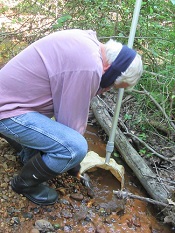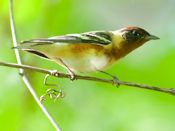
Saving Our Native Plant Site

In partnership with the National Park Service, FODMers have been working in the summer of 2020 to control invasive plants in the .065-acre native plant area. Volunteers have hauled out bags of plants like mile-a-minute (Persicaria perfoliata), Japanese stiltgrass (Microstegium vimineum), English ivy (Hedera helix) and porcelain berry (Ampelopsis brevipedunculata).
Invasive plants can outcompete natives and compromise the habitat, so it is important to try to keep them under control. Many native insects and other wildlife depend on the plants with which they co-evolved.
FODMer Has Two Photos in Virginia Wildlife

FODMer Jane Gamble had two photographs in Virginia Wildlife magazine’s July/August 2020 annual photography showcase which highlighted images from 111 photographers. One photo was of three blue-gray gnatcatcher nestlings begging for food. The second was a white-tailed doe deer with her fawn. The magazine is published by the Virginia Department of Wildlife Resources. Congratulations, Jane.
Comet Viewed from Dyke Marsh

FODMer Ed Eder snapped a photo of the newly-discovered comet, C/2020 NEOWISE on July 13 at 4:40 a.m. Ed was looking from Dyke Marsh north-northeast toward the middle of the Woodrow Wilson Bridge and up about 10 degrees. Ed suggests that after July 15, people should watch for it in the north-northwest sky at night about 80 minutes after sunset.
Studying the Habitat Quality of an Area Stream

On June 26, 2020, four FODM volunteers and one Westgrove P.A.C.K. volunteer conducted habitat quality testing in an unnamed intermittent stream flowing through Mount Vernon Park into west Dyke Marsh. This effort was led by Dan Schwartz and Ashley Palmer of the Northern Virginia Soil and Water Conservation District (NVSWCD).
From 9:30 a.m. to 12 noon, the group took 20 samples from the stream within a 100-meter span, with the goal of identifying 100 living benthic macroinvertebrates. They found these species: 13 scuds, three trueflies, one aquatic worm and one “other.”
Senator Mark Warner Visits, Celebrates Major Conservation Bill

Virginia U.S. Senator Mark Warner came to Belle Haven Park/Dyke Marsh on June 22, 2020 and championed the Senate’s June 19 approval of the Great American Outdoors Act. The bill would fully and permanently fund the Land and Water Conservation Fund (LWCF) at $900 million a year and allocate $9.5 billion to address the maintenance backlog on public lands, including national parks, refuges, U.S forests and other lands. The National Park Service has a $12 billion maintenance backlog; Virginia parks, $1.1 billion; the George Washington Memorial Parkway, $717 million.
Chronolog, Documenting Change in Dyke Marsh

Visitors to Dyke Marsh will find a photography station called Chronolog on the Haul Road trail at the native plant site, DMW-101. Unfortunately, our second station on the boardwalk across from Tulane Drive, DMW-102, was destroyed twice. Neither FODM or the U. S. Park Police know why it was apparently vandalized. At this time, FODM will not replace it at that site
This station helps document and better visualize landscape changes over time in the preserve. Changes in a landscape can be slow to see, whether they are seasonal changes, results of the restoration project or longer-term changes.
Spring Bird Breeding and Nesting

Several talented photographers documented breeding birds in Dyke Marsh this spring, 2020.
Warbler Wonders

Many people have enjoyed warblers migrating through Dyke Marsh this spring, 2020. Many species have bright colors. Some migrate from South America to northern Canada.
Barred Owls Raise Two Young in Dyke Marsh

Keen observers have watched the parents and two young barred owls (Strix varia) in Dyke Marsh this spring, 2020. Ed Eder captured the two owlets doing mutual preening on April 17 and Ed reported that they usually stick close together.
Barred owls are known for their haunting, baritone night call, “who cooks for you, who cooks for you-all.” They get their name from their “bars” or striped plumage. Generally, they roost during the day and hunt at night. Adults are around 21 inches in length and a little over a pound in weight. They tend to be in older forests, but are highly adaptable to varied habitats, including mixed forests and disturbed areas. “Barred owls are the opportunists of the owl world,” wrote Leigh Clavez in The Hidden Lives of Owls.
Yellow-headed Blackbird, a New Record

Dyke Marsh has had another first this spring, 2020 -- several sightings of a yellow-headed blackbird (Xanthocephalus xanthocephalus). In fact, it is a record for the George Washington Memorial Parkway according to Brent Steury, the Parkway’s Natural Resources Program Manager.
The beautiful blackbird in Dyke Marsh is a male with a stunning yellow head, black body, yellow breast and white markings on its wings. Females and immature males are brown-black with reduced yellow on the face, throat and brow. These birds typically nest in the West and Midwest in colonies, often alongside red-winged blackbirds in bullrushes or cattails. They forage on insects, grain and wet seeds.
A Bald Eagle Attacked an Osprey
An osprey (Pandion haliaetus) was a victim of a bald eagle (Haliaeetus leucocephalus) attack on Sunday afternoon, March 22, 2020. The bald eagle may have attacked the osprey trying to defend his or her territory or because of what is called kleptoparisitism when one species steals food from another. The osprey came to the ground after the attack and was stuck in some bushes. FODMers Rich Rieger and Sherman Suter extracted the bird and Rich wrapped it up in his coat. Despite some bleeding, the osprey settled down and Rich placed the bird on a picnic table. After a moment, the osprey took flight, seemed normal to the human eye and landed in the top of a tree.
Dyke Marsh Turned Neon Green

On March 20, 2020, around 7 a.m., several FODMers observed that the water in west Dyke Marsh and an unnamed stream flowing in the marsh was neon green. This part of the marsh is around 15 to 20 acres and west of the George Washington Memorial Parkway.
We contacted local, state and National Park Service officials. Fairfax County sent wastewater and hazardous materials staffers, the Virginia Department of Environmental Quality sent pollution experts and the National Park Service sent a staffer, all to inspect the site.


AlbertHerring-b4cc6b5cfb.jpg)



 Friends of Dyke Marsh, Inc. is a non-profit 501(c)(3) organization.
Friends of Dyke Marsh, Inc. is a non-profit 501(c)(3) organization.